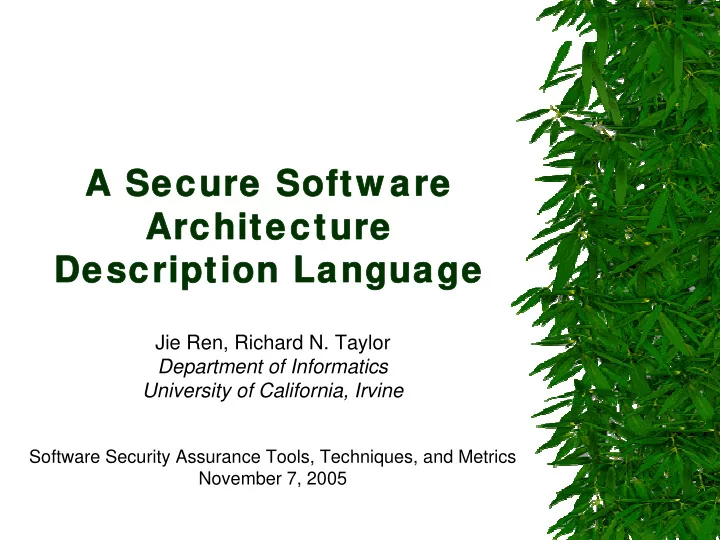

A Secure Softw are A Secure Softw are Architecture Architecture Description Language Description Language Jie Ren, Richard N. Taylor Department of Informatics University of California, Irvine Software Security Assurance Tools, Techniques, and Metrics November 7, 2005
http://www.isr.uci.edu/ Outline � Background and insight – Architecture and Security – Software connectors � Secure xADL – xADL – Access control models – XACML-based policy � Case study: secure coalition � Conclusion and future work A Secure Software Architecture Description Language 2
http://www.isr.uci.edu/ Main Goal � Integrate security and software architecture – Integrate – Architecture level – Security: integrity through access control – Software engineering perspective: how to express, check, and enforce A Secure Software Architecture Description Language 3
http://www.isr.uci.edu/ Re-architecting boosts security! Wing, IEEE Security & Privacy, 2003 A Secure Software Architecture Description Language 4
http://www.isr.uci.edu/ Traditional SA � Component-based Software Engineering � Software Architecture – Structure – Behavior � Process algebra (Wright), labeled transition system (Darwin) A Secure Software Architecture Description Language 5
http://www.isr.uci.edu/ Connectors � Should they be first class citizens? – Capture and reuse � Existing work – Taxonomy: Mehta 2000 – Assembly Language: Mehta 2004 – Constructions: Lopes 2003 – Transformation: Spitznagel 2001 � No rich security – Dependability: Spitznagel 2004 A Secure Software Architecture Description Language 6
http://www.isr.uci.edu/ Our Approach � Describe and enforce Architectural Access Control – Combine software architecture and security research – Based on the extensible xADL language – Adopt an integrated access control model: classic, role-based, trust management – Utilize XACML A Secure Software Architecture Description Language 7
http://www.isr.uci.edu/ Overview of xADL � XML-based extensible architecture description language � Component and connector � Types � Signatures and interfaces � Sub-architecture � Design-time and run-time � Tool support: ArchStudio � Extensible: configuration, execution A Secure Software Architecture Description Language 8
http://www.isr.uci.edu/ Unified Access Control � Classic Access Control – Subject, object, operation � Role-based Access Control – Use role as an indirection � Role-based Trust Management – Trust management: attributes – Inspired by Professor Ninghui Li’s work – Trust relationship between roles of different domains A Secure Software Architecture Description Language 9
http://www.isr.uci.edu/ Secure xADL � Concepts for Architectural Access Control – subject, principal, resource, privilege, safeguard, and policy � Integrate with xADL � The first effort to model these security concepts directly in an architectural description language A Secure Software Architecture Description Language 10
http://www.isr.uci.edu/ Subject � A subject is the user on whose behalf software executes. � Missing from traditional software architecture: – All of its components and connectors execute under the same subject, – The subject can be determined at design time, – It will not change during runtime, either advertently or intentionally – Even if there is a change, it has no impact on the software architecture. A Secure Software Architecture Description Language 11
http://www.isr.uci.edu/ Principal � A subject can take multiple principals , which are possessed credentials. � Classic access control: subjects � RBAC: roles � Trust management: keys, certificates, A Secure Software Architecture Description Language 12
http://www.isr.uci.edu/ Resource � A resource is an entity whose access should be protected. � Passive: files, sockets, etc. � Active: components, connectors A Secure Software Architecture Description Language 13
http://www.isr.uci.edu/ Privilege � Permissions describes a possible operation on an object. � Privilege describes what permissions a component possess depending on the executing subjects. � Privilege escalation vulnerabilities � Two types of privileges: – Traditional: read file, open sockets, etc. – Architectural: instantiation, connection, message routing, introspection A Secure Software Architecture Description Language 14
http://www.isr.uci.edu/ Safeguard � Safeguards are permissions that are required to access the interfaces of the protected components and connectors. � Architectural access control check A Secure Software Architecture Description Language 15
http://www.isr.uci.edu/ Policy � A policy specifies what privileges a subject should have to access resources protected by safeguards. � Numerous existing studies in the security community. � We focus on software engineering applicability for architectural modeling. � XACML – XML-based – Extensible: RBAC profile – Tool support A Secure Software Architecture Description Language 16
http://www.isr.uci.edu/ Contexts for Architectural Access Control � Access control decisions might be based on entities other than the decision maker and the protected resource. These relationships are the context. � Four types of context – The nearby components and connectors of the component and the connector – The explicitly modeled sub-architecture that contains the component and the connector – The type of the component and the connector, – The global architecture. � XACML’s combining algorithms supply a framework to combine these contexts A Secure Software Architecture Description Language 17
http://www.isr.uci.edu/ Syntax of Secure xADL <complexType name=”SecurityPropertyType"> <sequence> <element name="subject“ type="Subject"/> <element name="principal“ type="Principals"/> <element name="privilege“type="Privileges"/> <element ref="xacml:PolicySet"/> </sequence> <complexType> <complexType name="SecureConnectorType"> <complexContent> <extension base="ConnectorType"> <sequence> <element mame="security“ type="SecurityPropertyType"/> <sequence> <extension> <complexContent> </complexType> <!-- similar constructs for component, structure, and instance --> A Secure Software Architecture Description Language 18
http://www.isr.uci.edu/ Case Study: Secure Coalition A Secure Software Architecture Description Language 19
http://www.isr.uci.edu/ Secure Connector A Secure Software Architecture Description Language 20
http://www.isr.uci.edu/ Architectural Policy: Routing <connector id="UStoFranceConnector"> <security type="SecurityPropertyType"> <subject>US</subject> <Policy RuleCombiningAlgId="permit-overrides"> <Rule Effect="Permit"> <Target> <Subject><AttributeValue> USToFranceConnector <AttributeDesignator AttributeId="subject-id"/> <Resource><AttributeValue> RouteMessage <AttributeDesignator AttributeId="resource-id"/> <Action><AttributeValue> RouteMessage <AttributeDesignator AttributeId="action-id"/> <Condition FunctionId="string-equal"> <AttributeValue>Aircraft Carrier <Apply> <AttributeSelector RequestContextPath = " //context:ResourceContent/security:routeMessage/ messages:namedProperty[messages:name='type']/ messages:value/text() "/> <Rule RuleId="DenyEverythingElse" Effect="Deny"/> A Secure Software Architecture Description Language 21
http://www.isr.uci.edu/ Conclusion � Background and insight – Combine security and software architecture – Architectural Access Control � Approach – Extend xADL – A unified access control model – Subject, principal, resource, privilege, safeguard, and policy – XACML as the base policy syntax � Case study: secure coalition � Future work – Algorithm for architectural access control algorithm – Tool support A Secure Software Architecture Description Language 22
Recommend
More recommend